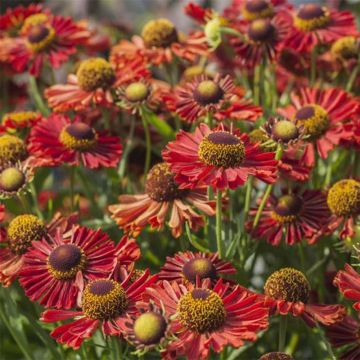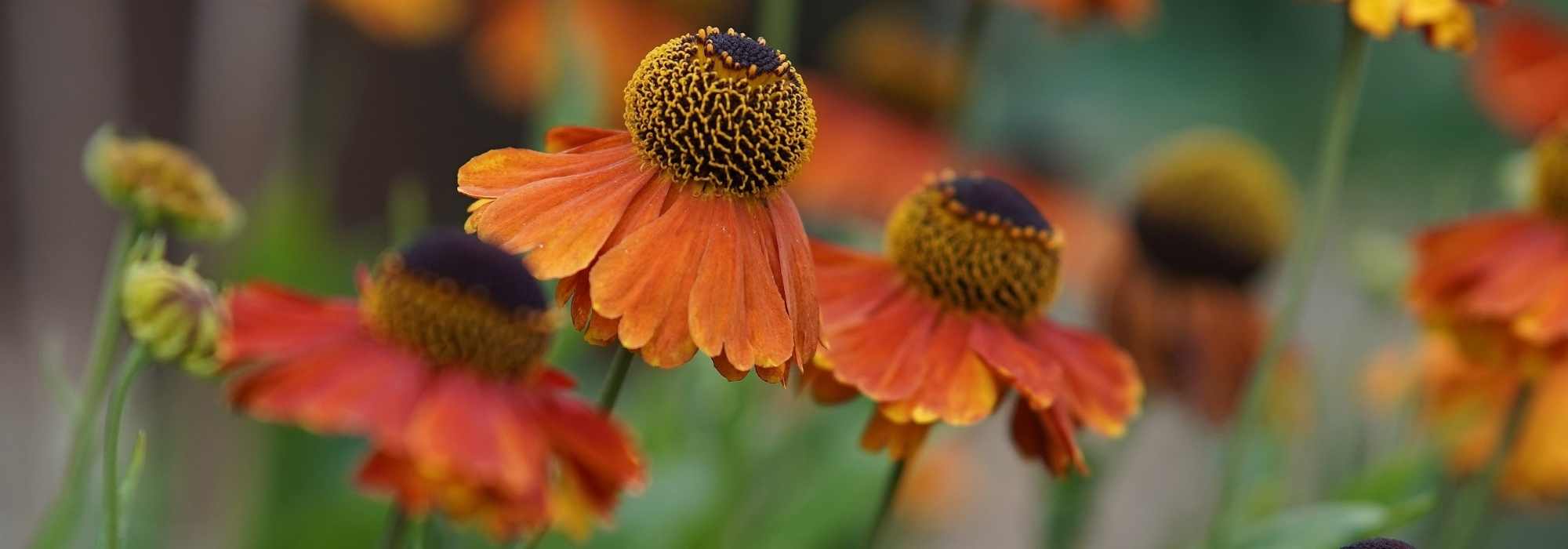

Helenium Poncho
Helenium Poncho
Helenium Poncho
Sneezeweed, Helen's flower, Dogtooth daisy
On the 3 ordered, Received a bucket, with a label, and only 1 leaf. The other 2 immediately planted. Called the customer service who took my complaint into consideration. Let's wait...
Marcel, 08/06/2021
Special offer!
Receive a €20 voucher for any order over €90 (excluding delivery costs, credit notes, and plastic-free options)!
1- Add your favorite plants to your cart.
2- Once you have reached €90, confirm your order (you can even choose the delivery date!).
3- As soon as your order is shipped, you will receive an email containing your voucher code, valid for 3 months (90 days).
Your voucher is unique and can only be used once, for any order with a minimum value of €20, excluding delivery costs.
Can be combined with other current offers, non-divisible and non-refundable.
Home or relay delivery (depending on size and destination)
Schedule delivery date,
and select date in basket
This plant carries a 12 months recovery warranty
More information
We guarantee the quality of our plants for a full growing cycle, and will replace at our expense any plant that fails to recover under normal climatic and planting conditions.

Would this plant suit my garden?
Set up your Plantfit profile →
Description
The 'Poncho' Helenium is a recent variety of Helenium with a modest stature that ensures excellent performance in flowerbeds. An additional asset for this plant is its truly flamboyant long summer flowering period. Its head-like flowers, resembling daisies, display a corolla whose colour evolves from gold-edged red to flame orange with a touch of soft red, centered around a large heart that transitions from brown to golden yellow. The beautiful dark green foliage perfectly complements the warm hue of the flowers. It is a robust perennial, easy to grow in the sun in moist soil. Its flowers are magnificent in a vase.
Natural species of Helenium are perennials native to North America, typically found in marshes or in moist, sunny locations. The 'Poncho' cultivar offers an extended summer flowering period, renewing itself from early August to late September, with intense colour and compact growth. The plant forms sturdy, branched leafy stems, reaching about 60cm (24in) in height. The leaves are coloured olive-green, lanceolate in shape, with slightly dentate margins, and are arranged alternately along the stems. The flowers, organized in head-like clusters, bloom at the tips of the stems. These clusters, 6cm (2in) in diameter, are centered around a large cone that gradually transitions from brown to stamens covered in yellow pollen. At the periphery, brightly coloured florets finely bordered in yellow fade to shades of orange, brick, or muted red. These colours are most striking when illuminated by the sun.
The 'Poncho' Helenium is a very hardy and disease-free plant. It thrives in ordinary but moist soil and very sunny exposures. Easy to grow, it blooms just as well in slopes and flowerbeds as it does in pots on the terrace or balcony. Despite all these qualities, Heleniums remain rare in gardens, perhaps because their warm tones herald the arrival of autumn. This Helenium pairs well with yellow summer blooms (Goldenrods), blue flowers (Catmints, buglosses, perennial salvias), as well as asters and grasses. It can also be combined with plants with purple foliage ('Little Devil' Ninebark, Berberis atropurpurea 'Nana', 'Black Lace' Elderberry) or golden foliage ('Goldmound' Spirea).
Helenium Poncho in pictures






Flowering
Foliage
Plant habit
Botanical data
Helenium
Poncho
Asteraceae
Sneezeweed, Helen's flower, Dogtooth daisy
Cultivar or hybrid
Other Helenium
View all →Planting and care
Plant the 'Poncho' Helenium in ordinary soil, provided it is fertile, moist but well-drained, by adding planting compost and/or well-decomposed compost. Choose a sunny position for it. Water regularly after planting, then only water in case of prolonged drought once it is established. This variety, which is not very tall, generally does not require staking, except perhaps in our windy or rainy regions. Prune the plant once the stems have turned black. Every 2 to 3 years, you can divide the clump in spring or autumn to regenerate the plant and give it renewed vigour.
Planting period
Intended location
Care
Planting & care advice
-
, onOrder confirmed
Reply from on Promesse de fleurs
Similar products
Haven't found what you were looking for?
Hardiness is the lowest winter temperature a plant can endure without suffering serious damage or even dying. However, hardiness is affected by location (a sheltered area, such as a patio), protection (winter cover) and soil type (hardiness is improved by well-drained soil).

Photo Sharing Terms & Conditions
In order to encourage gardeners to interact and share their experiences, Promesse de fleurs offers various media enabling content to be uploaded onto its Site - in particular via the ‘Photo sharing’ module.
The User agrees to refrain from:
- Posting any content that is illegal, prejudicial, insulting, racist, inciteful to hatred, revisionist, contrary to public decency, that infringes on privacy or on the privacy rights of third parties, in particular the publicity rights of persons and goods, intellectual property rights, or the right to privacy.
- Submitting content on behalf of a third party;
- Impersonate the identity of a third party and/or publish any personal information about a third party;
In general, the User undertakes to refrain from any unethical behaviour.
All Content (in particular text, comments, files, images, photos, videos, creative works, etc.), which may be subject to property or intellectual property rights, image or other private rights, shall remain the property of the User, subject to the limited rights granted by the terms of the licence granted by Promesse de fleurs as stated below. Users are at liberty to publish or not to publish such Content on the Site, notably via the ‘Photo Sharing’ facility, and accept that this Content shall be made public and freely accessible, notably on the Internet.
Users further acknowledge, undertake to have ,and guarantee that they hold all necessary rights and permissions to publish such material on the Site, in particular with regard to the legislation in force pertaining to any privacy, property, intellectual property, image, or contractual rights, or rights of any other nature. By publishing such Content on the Site, Users acknowledge accepting full liability as publishers of the Content within the meaning of the law, and grant Promesse de fleurs, free of charge, an inclusive, worldwide licence for the said Content for the entire duration of its publication, including all reproduction, representation, up/downloading, displaying, performing, transmission, and storage rights.
Users also grant permission for their name to be linked to the Content and accept that this link may not always be made available.
By engaging in posting material, Users consent to their Content becoming automatically accessible on the Internet, in particular on other sites and/or blogs and/or web pages of the Promesse de fleurs site, including in particular social pages and the Promesse de fleurs catalogue.
Users may secure the removal of entrusted content free of charge by issuing a simple request via our contact form.
The flowering period indicated on our website applies to countries and regions located in USDA zone 8 (France, the United Kingdom, Ireland, the Netherlands, etc.)
It will vary according to where you live:
- In zones 9 to 10 (Italy, Spain, Greece, etc.), flowering will occur about 2 to 4 weeks earlier.
- In zones 6 to 7 (Germany, Poland, Slovenia, and lower mountainous regions), flowering will be delayed by 2 to 3 weeks.
- In zone 5 (Central Europe, Scandinavia), blooming will be delayed by 3 to 5 weeks.
In temperate climates, pruning of spring-flowering shrubs (forsythia, spireas, etc.) should be done just after flowering.
Pruning of summer-flowering shrubs (Indian Lilac, Perovskia, etc.) can be done in winter or spring.
In cold regions as well as with frost-sensitive plants, avoid pruning too early when severe frosts may still occur.
The planting period indicated on our website applies to countries and regions located in USDA zone 8 (France, United Kingdom, Ireland, Netherlands).
It will vary according to where you live:
- In Mediterranean zones (Marseille, Madrid, Milan, etc.), autumn and winter are the best planting periods.
- In continental zones (Strasbourg, Munich, Vienna, etc.), delay planting by 2 to 3 weeks in spring and bring it forward by 2 to 4 weeks in autumn.
- In mountainous regions (the Alps, Pyrenees, Carpathians, etc.), it is best to plant in late spring (May-June) or late summer (August-September).
The harvesting period indicated on our website applies to countries and regions in USDA zone 8 (France, England, Ireland, the Netherlands).
In colder areas (Scandinavia, Poland, Austria...) fruit and vegetable harvests are likely to be delayed by 3-4 weeks.
In warmer areas (Italy, Spain, Greece, etc.), harvesting will probably take place earlier, depending on weather conditions.
The sowing periods indicated on our website apply to countries and regions within USDA Zone 8 (France, UK, Ireland, Netherlands).
In colder areas (Scandinavia, Poland, Austria...), delay any outdoor sowing by 3-4 weeks, or sow under glass.
In warmer climes (Italy, Spain, Greece, etc.), bring outdoor sowing forward by a few weeks.




























































